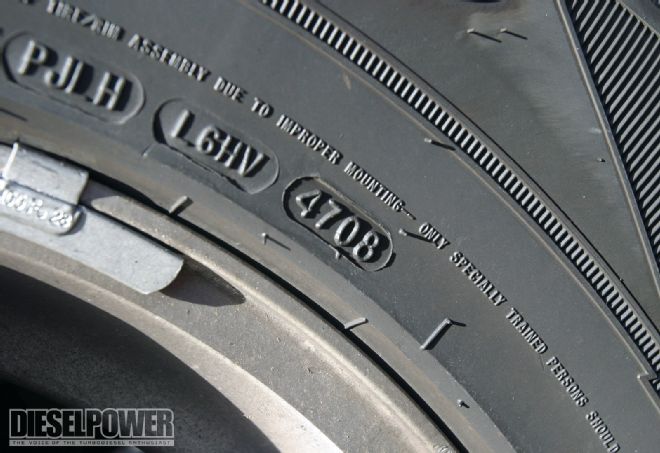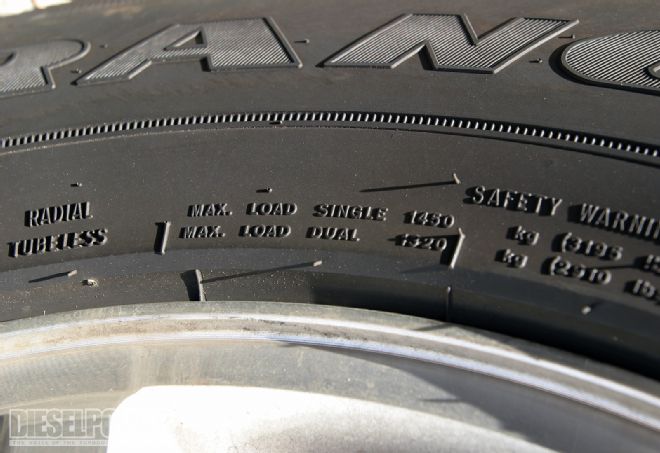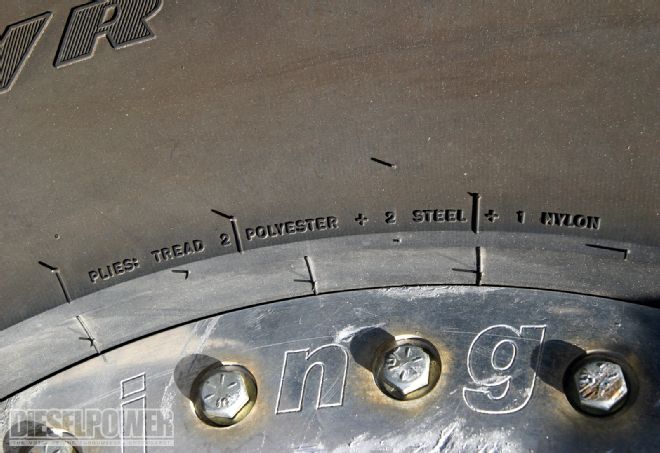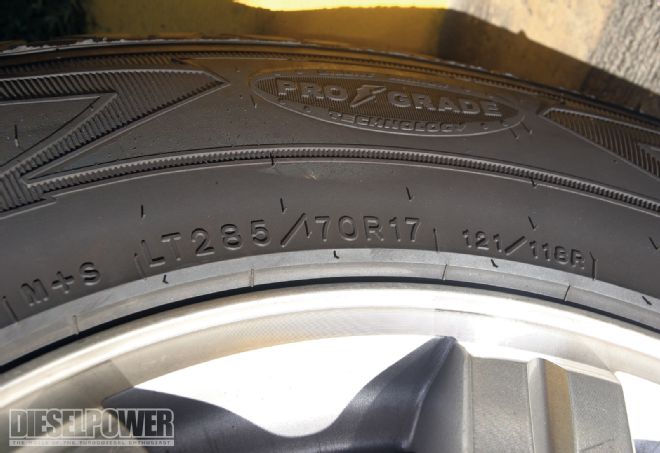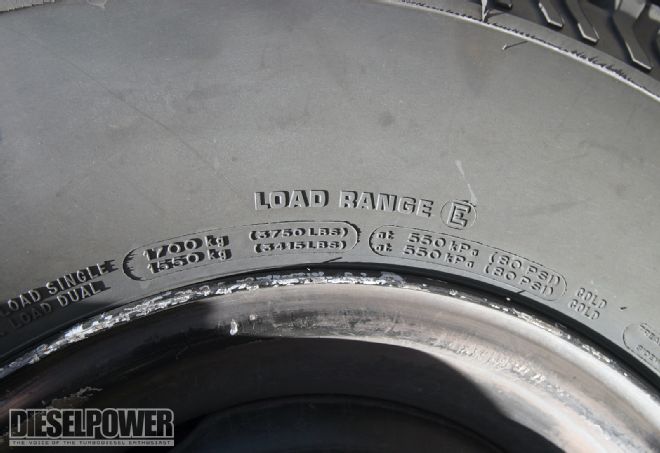Everybody needs tires. Whether you drive your vehicle off-road, pull a trailer, or just jam around town, tires are your all-important contact patch to the ground. There are many types of tires available to the diesel enthusiast, so let's start by decoding the sidewall. After that, we'll discuss load and speed ratings, as well as tread patterns and sizes. Finally, we'll talk about usage and taking proper care of your tires.
DECODING THE SIDEWALL
Size
If you look on the sidewall of the tire, you'll see a series of numbers, like LT285/75R16 or 37x13.50R20 LT-this is the tire size. In either case, LT stands for light-truck tire. In the first example, 285 stands for the tire's width in millimeters, 75 means the sidewall of the tire is 75 percent the size of its width, R stands for radial, and 16 is the rim diameter in inches. In the second example, the tire is simply 37 inches tall, 13.50 inches wide, is a radial, and mounts on a 20-inch wheel.

| tire Test Guide fierce Attitude Tire
If you don't like the metric version, it can easily be converted to the standard form of measurement. If we first divide 285 by 10, we change millimeters to centimeters, arriving at 28.5 centimeters. Since 1 centimeter equals 0.393 inch, we next multiply 28.5 by 0.393, arriving at the tire's width of 11.2 inches. Next comes the tricky part. The sidewall is 75 percent of the width in this case, so 11.2 times 0.75 equals 8.4 inches. Since a tire sitting on the ground has a bottom and a top sidewall, we must multiply that answer by 2, arriving at 16.8 inches. Finally, we add the height of the rim (in this case 16 inches) to arrive at the final 32.8-inch tire height.
Construction
Light-truck tires are a bit different than regular passenger car tires. The overall tire is much stiffer and heavier than a car tire, thanks to multiple plies (cross sections of polyester, steel, nylon, or armid that run perpendicular to the tread) and can be inflated and run at a much higher pressure, increasing its load capacity and decreasing on-road rolling resistance. Since most diesel owners use their trucks to tow or haul loads, we'd never suggest putting a passenger car tire on a truck-they're simply not up to the task.
Load Rating, Load Capacity, And Speed Rating Almost all diesel trucks come with E-load-rated tires from the factory. These tires are usually rated at a capacity of more than 3,000 pounds per tire. In the case of Project 300 (our '87 Ford F-250), our E-rated tires came in at 3,750 pounds per tire. Load ratings can be misleading, however, as the C load rating on Petersen's 4Wheel & Off-Road's 42-inch-tired Super Duty carries the exact same load capacity as our D-rated tires on Diesel Power's Jeep Cherokee. So, more than load rating, load capacity is actually what you should be looking at. If you're unsure what capacity your truck tires need, default to a tire capacity that is equal to, or higher than stock. Last but not least, is the speed rating. Tire speed ratings come in letters, which designate a maximum continuous speed that the tire was designed for. In passenger car tires, the speed rating is always after the tire size. It's connected to the load index number and will say something like 95H. The H is the speed rating. On truck tires, the speed rating can be harder to find, or not there at all. Still, keep in mind that almost all tires are rated to at least 99 mph, so there's virtually no chance of a tire failure due to speed, at any legal speed limit. If you're unsure about your speed rating, it's best to consult the tire's manufacturer.
Tread Patterns
Tires come in many different types of tread patterns. These tread patterns determine the behavior of the tire in various conditions. For an extreme example, let's use a racing slick, which has no tread pattern at all-it's simply smooth on the face of the tire. This smooth face means a very large contact patch on the road, and great traction on dry asphalt. If the weather turns foul or this type of tire is expected to perform in mud, it suddenly becomes a very bad tire. Without any type of tread, it can't sink into rocks, mud, or dirt-it simply rides on top. A smooth tire on an uneven surface leads to a very small contact area, which is very bad for traction. For this reason, mud tires have very large blocks of tread that can sink into the nooks and crannies of uneven surfaces to find traction. These two types of tires-slicks and mud tires-fall at completely different ends of the tread pattern spectrum. Most tires you'll buy for your truck fall somewhere between these two. Normal, factory light-truck tires are in the middle, whereas an aftermarket all-terrain tire is slightly toward the mud tire end of the spectrum. To find out which type of tire is right for you, we'll explore more when we discuss tire usage.
Usage
Now that you're armed with sidewall data and informed about tire types, we'll get into which tire you should choose. When looking for a tire, the main thing to consider is the truck's intended usage. If you tow and are looking for good fuel economy, 44-inch mud tires aren't for you. But if you're looking to blast through the mud, they are perfect. For most diesel owners, an all-terrain-type tire will work just fine, although there are exceptions. If you tow often and your truck sees mostly highway use, a tire with a less-aggressive tread pattern will offer a noise reduction and better tire life than an all-terrain. Although mud tires look cool, the fact is that almost nobody actually needs them-unless they have built a rig specifically to tackle trails or live and work in a remote area. Also remember that a heavier tire and wheel combination will greatly affect fuel mileage. Going from a 31- or 32-inch tire to a huge lift and 35s or 37s will decrease fuel economy by 10 to 20 percent. We have a feeling that most diesel owners who complain about poor fuel economy have a heavy right foot and a lifted truck with big tires and heavy wheels.
Tire Maintenance
Letting tires sit, especially in extreme weather, is the quickest way to destroy a perfectly good tire. Also, letting the pressure run low or letting the vehicle sit in one spot for too long can create a flat spot, which will make your truck ride horribly. Over and under inflation can also lead to trouble, causing the tire to wear prematurely. For maximum tire life, drive your vehicle often, always keep your tires properly inflated, and rotate them regularly. And if you want your tires to last longer, gradually brake, turn, or accelerate instead of burning rubber. Finally, don't expect them to last forever. They're called wear items for a reason, and eventually through age or use, it'll be time to buy a new set of tires.
EXPLAINING THE CODE
LT = Light Truck, P = Passenger
LT285/70R17 121/118R

| tire Test Guide tire Size Information
Width Of Tire In Millimeters
LT
285/70R17 121/118R
Aspect Ratio (Ratio Of Width To Height)
LT285/
70R17 121/118R
Radial
LT285/70
R17 121/118R
Diameter Of Wheel In Inches
LT285/70R
17 121/118R
Load Index
LT285/70R17
121/118R
Speed Rating
LT285/70R17 121/118
R
